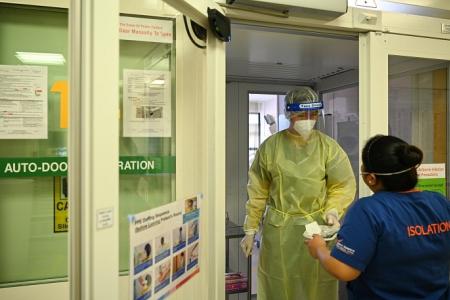2,102 people in S’pore have died from Covid-19 up to June
There have been 2,102 Covid-19 deaths here since the start of the pandemic in 2020 to June 2024, the Ministry of Health (MOH) told The Straits Times – a figure that public health experts describe as low.
While the experts say Singapore has done well in the fight against Covid-19, the pandemic nevertheless pushed up the age-standardised death rate – an indicator that allows for a fair comparison of mortality rates over time as it removes the effect of a rapidly ageing population.
Singapore’s age-standardised death rate rose to a high of 5.9 per 1,000 resident population in 2022, up from 5.2 in 2020 and 5.6 in 2021. In 2023, it went back down to 5.6.
The MOH gave ST data on Covid-19 deaths in response to questions on the sharp increases in the total number of deaths over the past few years.
A total of 26,888 people died last year, just 0.01 per cent lower than the 26,891 deaths in 2022, based on the Report on Registration of Births and Deaths 2023 published by the Immigration and Checkpoints Authority in July.
The 2023 figure was 10.7 per cent higher than the 24,292 deaths in 2021. In 2020, 22,054 people died.
An MOH spokeswoman said: “To observe mortality trends over time, age-standardised death rates are used instead of absolute numbers of deaths, as they remove the effect of changing population structure, such as that caused by an ageing population.”
From 2013 to 2020, the age-standardised death rates fell despite the absolute number of deaths increasing due to Singapore’s ageing population, the spokeswoman said. For example, the age-standardised death rate was 6.1 per 1,000 resident population in 2013, but fell almost year on year to 5.2 per 1,000 resident population in 2020.
Meanwhile, the absolute number of deaths rose steadily year on year from 18,938 deaths in 2013 to 22,054 deaths in 2020.
The MOH spokeswoman said the falling age-standardised death rates were likely due to “our preventive health efforts, earlier diagnosis and better treatment of diseases”.
But from 2020 to 2022, the age-standardised death rates increased as they were “driven by the Covid-19 pandemic”, she added.
She said that while Singapore had one of the lowest mortality rates in the world during the pandemic, more people still died during that time.
The increase in the age-standardised death rates in 2021 was mainly due to the Delta wave in the last few months of that year. Before the Delta wave, there were few Covid-19 deaths, the MOH spokeswoman added.
In 2022, the increase in the age-standardised death rates was due to three much larger Covid-19 waves driven by the Omicron BA.1/2, BA.4/5 and XBB variants.
“Although protected by high vaccination coverage, the large number of infections inevitably resulted in more deaths associated with Covid-19,” the MOH spokeswoman said.
From 2022 to 2023, the age-standardised death rates fell again, which reflected a return to pre-Covid-19 trends.
The MOH spokeswoman said the impact of Covid-19 on mortality rates was lower in 2023 as the XBB subvariants and JN.1 waves were smaller than those in 2022.
The top causes of deaths in Singapore in the past five years were cancer, ischaemic heart diseases, pneumonia and cerebrovascular diseases, which are conditions that affect blood flow to the brain, such as stroke.
Get The New Paper on your phone with the free TNP app. Download from the Apple App Store or Google Play Store now


